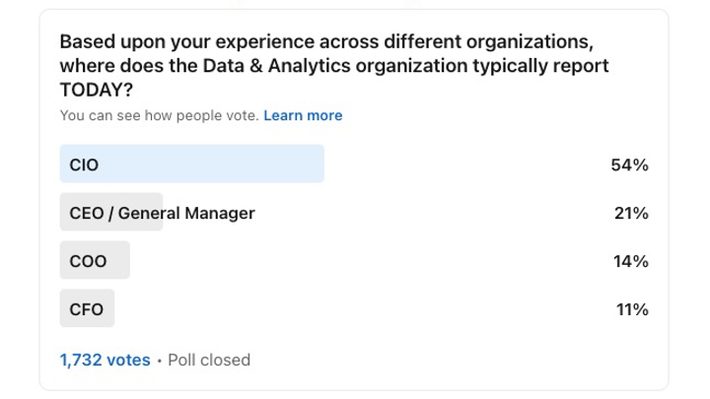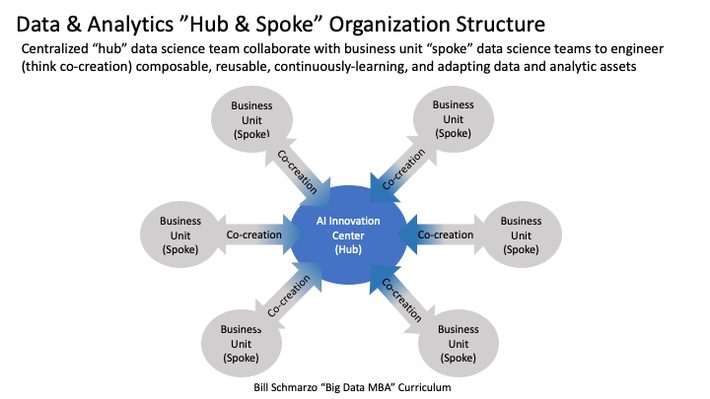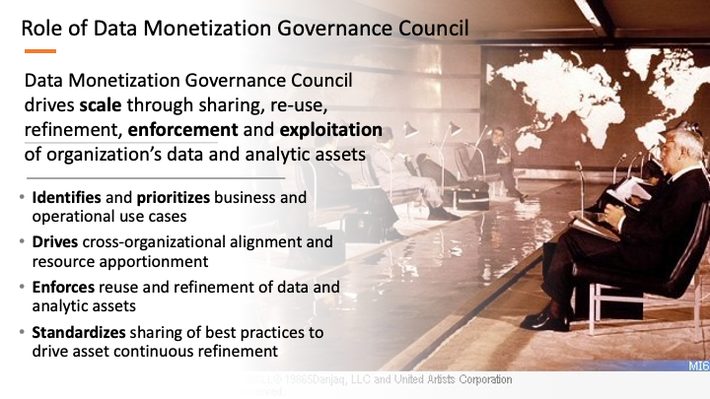
Here, let’s start this blog with some controversy:
For most organizations, data monetization is a total waste of time
I’ve been having lots of conversations recently about where the Data and Analytics organization should report. Good anecdotal insights, but I wanted to complement those conversations with some raw data. So, I ran a little LinkedIn poll (thanks to the nearly 2,000 people who responded to the poll) that asked the question: Based upon your experience across different organizations, where does the Data & Analytics organization typically report TODAY? The results are displayed in Figure 1.

Figure 1: Where does the Data & Analytics organization typically report TODAY?
The poll results in Figure 1 were incredibly disappointing but at least they help me understand why a data monetization conversation for most organizations is a total waste of my time.
From the poll, we learn that in 54% of organizations, the Data & Analytics organization reports to the Chief Information Officer (CIO). The data monetization conversation is doomed when the Data & Analytics organization reports to the CIO. Why? Because the Data & Analytics initiatives are then seen as technology efforts, not business efforts, by the business executives. And if data and analytics are viewed as technology capabilities and not directly focused on deriving and driving new sources of customer, product, and operational value, then there is no data monetization conversation to be had. Period.
Arguments for why the Data and Analytics function SHOULD NOT report to the Chief Information Officer (CIO) include:
- The CIO’s primary focus is on keeping the operational systems (ERP, HR, SFA, CRM, BFA, MRM) up and running. If one of these systems go down, then the business grinds to a halt – no orders get taken, no products get sold, no supplies get ordered, no components get manufactured, etc. Ensuring that these systems never go down (and stay safe from hackers, cyberattacks, and ransomware) is job #1 for the CIO. Unfortunately, that means that data and analytics are second class citizens in the eyes of the CIO as data and analytics are of less importance to the critical operations of the business.
- And while everyone is quick to point out that the CIO typically has responsibility for the data warehouse and Business Intelligence, the Data Warehouse and BI systems primarily exist to support the management, operational, and compliance reporting needs of the operational systems (see SAP buying Business Objects).
- Finally, the head of the Data & Analytics organization (lets call them the Chief Data & Analytics Officer or CDAO) needs to be the equal to the CIO when it comes to the senior executive discussions and decisions about prioritizing the organizations technology, data, and analytics investments. If the CDAO reports to the CIO, then the data and analytics investments could easily take a back seat to the operational system investments.
Let’s be very honest here, packaged operational systems are just sources of competitive parity. I mean, it’s really hard to differentiate your business when everyone is running the same SAP ERP, Siebel CRM, and Salesforce SFA systems. Plus, no one buys your products and services because you have a better finance or human resources system.
So, organizations must elevate the role of the data and analytics organization if they are seeking to leverage their data to derive and drive new sources of customer, product, and operational value. Consequently, the arguments for why the Data and Analytics function (or CDAO) SHOULD report to the CEO, General Manager, or Chief Operating Officer include:
- In the same way that oil was the fuel that drove the economic growth in the 20th century, data will be the driver of economic growth in the 21st century. Data is no longer just the exhaust or byproduct from the operations of the business. In more and more industries, data IS the business. So, the CDAO role needs to be elevated as an equal in the Line of Business executives to reflect the mission critical nature of data and analytics.
- One of the biggest challenges for the Data and Analytics function is to drive collaboration across the business lines to identify, validate, value, and prioritize the business and operational use cases against which to apply their data and analytics resources. Data and analytics initiatives don’t fail due to a lack of use cases, they fail because they have too many. As a result, organizations try to peanut butter their limited data and analytic resources across too many use cases leading to under-performance in each of them. The Data and Analytics function needs to stand as an equal in the C-suite to strategically prioritize the development and application of the data and analytic assets.
- A key priority for the Data and Analytics function is to acquire new sources of internal (social media, mobile, web, sensor, text, photos, videos, etc.) and external (competitive, market, weather, economic, etc.) data that enhances the data coming from the operational systems. These are data sources that don’t typically interest the CIO. The Data and Analytics function will blend these data sources to uncover, codify, and continuously-enhance the customer, product, and operational insights (predicted propensities) across a multitude of business and operational use cases (see the Economics of Data and Analytics).
- It is imperative that all organizations develop a data-driven / analytics-empowered culture where everyone is empowered to envision where and how data and analytics can derive and drive new sources of value. That sort of empowerment must come from the very top of the organization. Grassroots empowerment efforts are important (Catalyst Networks), but ultimately it is up to the CEO and/or General Manager to create a culture where everyone is empowered to search for opportunities to exploit the unique economic characteristics of the organization’s data and analytics.
The Growing Importance of the AI Innovation Office
To fully exploit their data monetization efforts, leading-edge organizations are creating an AI Innovation Office that is responsible for:
- Testing, validation, and training on new ML frameworks,
- Professional development of the organization’s data engineering and data science personnel
- “Engineering” ML models into composable, reusable, continuously refining digital assets that can be re-used to accelerate time-to-value and de-risk use case implementation.
The AI Innovation Office typically supports a “Hub-and-Spoke” data science organizational structure (see Figure 2) where:
- The centralized “hub” data scientist team collaborates (think co-create) with the business unit “spoke” data scientist teams to co-create composable and reusable data and analytic assets. The “Hub” data science team is focused on the engineering, reusing, sharing, and the continuous refinement of the organization’s data and analytic assets including the data lake, analytic profiles, and reusable AI / ML models.
- The decentralized “spoke” data science team collaborates closely with its business unit to identify, define, develop, and deploy AI / ML models in support of optimizing the business unit’s most important use cases (think Hypothesis Development Canvas). They employ a collaborative engagement process with their respective business units to identify, validate, value, and prioritize the use cases against which they will focus their data science capabilities.

Figure 2: Hub-and-Spoke Data Science Organization
The AI Innovation Office can support a data scientist rotation program where data scientists cycle between the hub and the spoke to provide new learning and professional development opportunities. This provides the ultimate in data science “organizational improv” in the ability to move data science team members between projects based upon the unique data science requirements of that particular use case (think Teams of Teams).
Finally, another critical task for the AI Innovation Office is to be a sponsor of the organization’s Data Monetization Council that has the corporate mandate to drive the sharing, reuse, and continuous refinement of the organization’s data and analytic assets. If data and analytics are truly economic assets that can derive and drive new sources of customer, product, and operational value, then the organization needs a governance organization with both “stick and carrot” authority for enforcing the continuous cultivation of these critical 21st century economic assets (see Figure 3).

Figure 3: Role of Data Monetization Governance Council
A key objective of the Data Monetization Governance Council is to end data silos, shadow IT spend, and orphaned analytics that create a drag on the economic value of data and analytics. And for governance, to be successful, it needs teeth. Governance must include rewards for compliance (e.g., resources, investments, budget, and executive attention) as well as penalties for non-compliance (e.g., withholding or even clawing back resources, investments, budget, and executive attention). If your governance practice relies upon cajoling and begging others to comply, then your governance practice has already failed.
Summary
So, in summary, yes, for most organizations (54% in my poll), the data monetization conversation is a total waste of time because data monetization conversation doesn’t start with technology but starts with the business. That means that the Data and Analytics function must have a seat in the C-suite, otherwise the data monetization conversation truly is a waste of time.
By the way, I strongly recommend that you check out the individual comments from the nearly 2,000 folks who responded to my LinkedIn poll. Lots of very insightful and provocative comments. Yes, that is the right way to leverage social media!!
